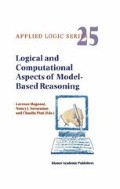Abstract
In this paper we present a diagrammatic inference scheme that can be used in the proof and discovery of diagrammatic theorems. First, we present the theory of abstraction markers and notational keys for explaining how abstraction can be incorporated in the interpretation of graphics through both syntactic and semantic means. We also explore how the process of reinterpretation of graphics is essential for learning and proving graphical theorems. Then, we present the diagrammatic inference scheme; it is illustrated with the proof of the theorem of the sum of the odd numbers. The paper concludes with a discussion on the relation between abstraction, visualization, interpretation change and learning, applied to understand a purely diagrammatic proof of the Theorem of Pythagoras.
Access this chapter
Tax calculation will be finalised at checkout
Purchases are for personal use only
Preview
Unable to display preview. Download preview PDF.
References
Boolos, G.S. and Jeffrey, R.C., 1990, Computability and Logic, Cambridge University Press.
Brachman, R.J. and Schmolze, J.G. 1985, An Overview of the KL-ONE Knowledge Representation System, Cognitive Science 9:171–216.
Bronowski, J., 1981, The Ascent of Man, BBC Corporation, London, pp. 155–188.
Bundy, A. and Richardson, J., 1999, Proofs about lists using ellipsis, in: Proceedings of 6th International Conference, Logic for Programming and Automated Reasoning, H. Ganzinger, D. McAllester, and A. Voronkov, eds., LNAI 1705, Springer-Verlag, pp. 1–12.
Chandrasekaran, B., 1997, Diagrammatic representation and reasoning: some distinctions, in: Working notes on the AAAI-97 Fall Symposium Reasoning with Diagrammatic Representations II. MIT, November 1997.
Foo, N.Y., Pagnucco, M., and Nayak, A.C., 1999, Diagrammatic proofs, in: Proceedings of the 16th International Joint Conference on Artificial Intelligence, IJCAI-99, Stockholm, Aug 1999, Morgan Kaufmann, pp. 378–383.
Funt, B.V., 1980, Problem-solving with diagrammatic representations, Artificial Intelligence 13:210–230.
Gurr, C., Lee, J., and Stenning, K., 1998, Theories of diagrammatic reasoning: Distinguishing component problems, Minds and Machines 8:533–557.
Hayes, J.P., 1985, Some problems and non-problems in representation theory, in: Readings in Knowledge Representation, R. Brachman and H. Levesque, eds., Morgan and Kaufmann, Los Altos, California, pp. 3–22.
Jamnik, M., 1999, Automating Diagrammatic Proofs of Arithmetic Arguments, Ph. D. Thesis, University of Edinburgh.
Johnson-Laird, P.N., 1983, Mental Models: Towards a Cognitive Science of Language, Inference, and Consciousness, Cambridge University Press, Cambridge.
Nelsen, R.B., 1993, Proofs without Words: Exercises in Visual Thinking, The Mathematical Association of America.
Pineda, L., 1989, Graflog: a Theory of Semantics for Graphics with Applications to Human-Computer Interaction and CAD Systems, PhD thesis, University of Edinburgh, UK.
Pineda, L.A., 1992, Reference, synthesis and constraint satisfaction, Computer Graphics Forum, 11(3):C–333–C–344.
Sloman, A., 1985, Afterthoughts on Analogical Representations, in: Readings in Knowledge Representation, R. Brachman and H. Levesque, eds., Morgan and Kaufmann, Los Altos, California, pp. 431–440.
Stenning, K. and Oberlander, J., 1995, A cognitive theory of graphical and linguistic reasoning: logic and implementation, Cognitive Science 19:97–140.
Wittgenstein, L., 1953, Philosophical Investigations, Basil Blackwell, Oxford.
Author information
Authors and Affiliations
Editor information
Editors and Affiliations
Rights and permissions
Copyright information
© 2002 Springer Science+Business Media Dordrecht
About this chapter
Cite this chapter
Pineda, L.A. (2002). Diagrammatic Inference and Graphical Proof. In: Magnani, L., Nersessian, N.J., Pizzi, C. (eds) Logical and Computational Aspects of Model-Based Reasoning. Applied Logic Series, vol 25. Springer, Dordrecht. https://doi.org/10.1007/978-94-010-0550-0_4
Download citation
DOI: https://doi.org/10.1007/978-94-010-0550-0_4
Publisher Name: Springer, Dordrecht
Print ISBN: 978-1-4020-0791-0
Online ISBN: 978-94-010-0550-0
eBook Packages: Springer Book Archive

